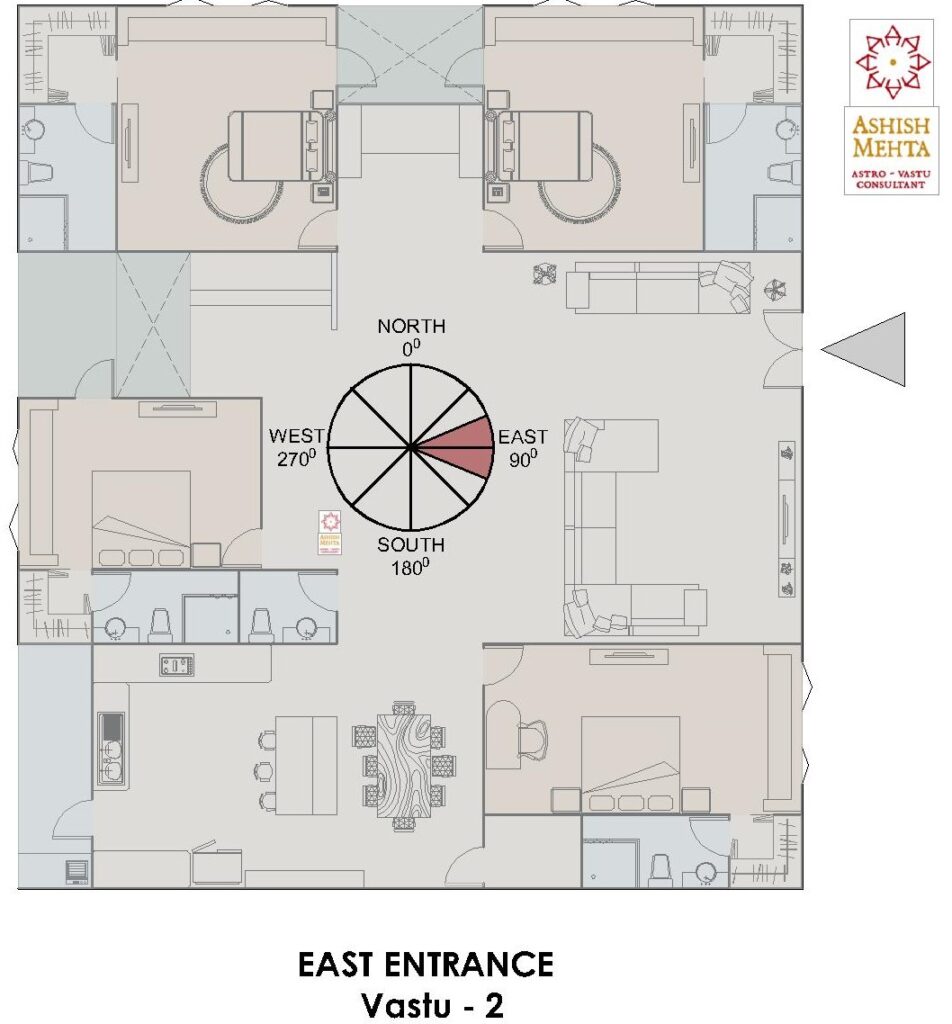In the world of Vastu construction, directions are very important. Each part of a Vastu is placed in a specific direction. But how do we figure out these directions in Vastu Shastra? We often watch videos and read articles to learn Vastu tips and secrets to benefit from our Vastu better.
To follow Vastu advice correctly, it’s essential to understand directions well. People believe that knowing directions well can bring benefits from all sides. Even in the Yajur Veda, there’s a prayer asking for blessings from all directions.
दिशश्च मे शुभः
– यजुर्वेद
“Oh God, may all the directions provide me with benefits after I acquire knowledge about them.”
In this article, we’ll explore how to mark directions in Vastu and the principles used to determine directions in Vastu Shastra. The first question is: Should we decide on the Vastu’s facing direction when entering or leaving it?
According to Vastu Shastra texts, the direction you face when leaving your Vastu determines its facing direction. So, if you face North when leaving through the main door, your Vastu is considered North-facing. If you face East, then it’s an East-facing Vastu.
There are three sources that mention this rule. The first is from the ‘Shabdakalpadruma’ which says:
“द्वारति निर् गच्छति गृह आभ्यन्तरात् अनेन ईति।”
The second reference is from the ‘Brahmavaivarta Purana’ with the verse:
“गृहिणां शुभदं द्वारं प्राकारस्य गृहस्य च।”
And the third reference is from the ‘Vastu Ratnakar’ with the verse:
“दक्षिणाः स वै प्रोक्तः मन्दिरान् निः सृते सति।”
All these sources agree that the direction we face when leaving a Vastu is considered its direction.
Now, let’s address the second important question:
Where should we mark the direction of our Vastu from? This has been a topic of confusion. People often debate whether we should decide the direction based on the main door or the center of the Vastu.
In all Vastu Shastra texts, it is clearly mentioned that we should mark the direction from the center of the Vastu. Two famous sources support this idea. The first is from the ‘Mayamatam’, which says:
“गृहीत वास्तु मध्ये तु समं कृत्वा भुवः स्थलम्।”
The second reference is from the ‘Vishwakarma Prakash‘, which states:
“तस्मिन् दिक् साधनं कार्यं वृत्त मध्यगते दिशि।”
From these references, it’s clear that to determine the direction of our Vastu, we should go to the center of our Vastu and locate the main entrance from there. To understand directions better, we must grasp some key points.
Firstly, North isn’t just a single point; it’s a whole zone. You’ve probably seen the ‘N’ symbol on maps and building plans, representing the North direction. This sets the reference point for all other directions. With a compass showing 360 degrees and 8 directions, each direction covers 45 degrees. North is at 0 degrees, East at 90 degrees, South at 180 degrees, and West at 270 degrees. North’s zone spans 45 degrees, split into 22.5 degrees to the left and 22.5 degrees to the right of 0 degrees. Likewise, East has a 45-degree zone split around 90 degrees. By following this pattern, we can locate all directions.
The second point is figuring out the facing direction of your Vastu with the main entrance. Simply find the center of your Vastu—whether it’s a shop, factory, office, or house—and stand there to determine the directions. This is how you can identify which way your Vastu is facing. Let me explain this with some examples.

the main door is in the North-East zone from the center, indicating a North-East facing Vastu, also known as the Ishaan corner facing Vastu.

the main door is in the East zone from the center, showing an East facing Vastu.

the main door is in the South-East zone from the center, making it a South-East facing Vastu, known as the Agni corner facing Vastu.
Interestingly, when determining the facing direction of the Vastu while standing inside and facing the main door, the direction is consistently East. This highlights the importance of marking directions from the center of the Vastu, not from any other position. Developers and Vastu consultants may indicate different directions, but it’s crucial to verify from the Vastu center to avoid any misinformation. Always remember, the true direction of the Vastu is determined from its center.
People often wonder if Vastu principles for the North direction differ between the Northern and Southern hemispheres. To make decisions based on direction, we must use a compass properly. The compass on devices like smartphones shows two North directions: True North and Magnetic North. There’s also Astronomical North, closely aligned with True North. It’s essential to focus on True North as Magnetic North varies with location due to magnetic declination. In the U.S., the magnetic declination is about +/- 20 degrees, leading to a 20-degree difference between True North and Magnetic North readings. In India, the magnetic declination is around 45 degrees and 16 minutes East. It’s crucial to consider this declination for accurate direction determination.
In Vastu Shastra texts, it’s advised to base decisions on True North or Astronomical North. In ancient times, a method called ‘ShankuSodhan Prakriya’ determined directions using a verse from Mayamatam.
वक्ष्येऽहं दिक् परिच्छेदं शङ्कुना अर्कोदये सति।
उत्तरायणमासे तु शुक्लपक्षे शुभोदये।।
– मयमतम्
“We should decide direction based on North according to Shukla Paksha and Solar Sankranti, not from magnetic North.”
The verse emphasizes deciding direction based on North according to Shukla Paksha and Solar Sankranti, not Magnetic North. By following True North, Vastu Shastra principles remain consistent globally, indicating similarities between the Northern and Southern hemispheres. Vastu Shastra principles rely on Earth’s position and movement in the sky, as Earth serves as the fundamental Vastu, as stated in the Mayamatam Tika, affirming that all Vastu Shastra principles are universal.
भूः एव मुख्य वास्तुः तस्मात् वास्तु वैश्विकः।
– मयमतम् टिका
“All the principles of Vastu Shastra are universal.”
To find directions in Vastu, locate the center of your space and mark all directions using a compass showing true North. Identify the zone where the main entrance is placed from the center, known as the facing direction. This method ensures proper alignment in Vastu.
Shubham Bhavatu.







